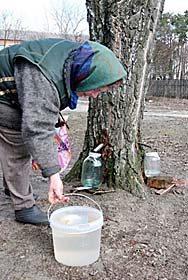So we put a picture up in one of our market reports and had a number of responses, all of which testify to the cross-pollination of food in Ukraine (and to the power of crowdsourcing!) That's not surprising given the country's important place on both sea and overland trade routes. Food traditions in Ukraine have come from what the land itself can produce, but also from traders coming across the Black Sea; settlers coming down from Russia, Turkey, and the Caucauses--and now, of course, from around the world.
This treat is called churchkhela in Georgia, rojik in Armenia, or Üzüm pekmezi (grape molasses) in Turkey. It's nuts strung out along a string and then dipped repeatedly in grape juice mixed with flour and sugar. A Google image search shows me mostly natural colors, but these brightly colored ones (probably food coloring) appear to be a newish innovation. Thanks to Florian Pinel, who blogs at Food Perestroika: Adventures in Eastern Bloc Cuisine, here's a recipe:
Churchkhela
10 qt grape juice [white or purple depending on your color preference]
1 lb sugar
2 1/4 lb flour
2 lb walnuts halves (or almonds, dried fruits…)
- In a pot, reduce the grape juice over low heat for about 3 hours, progressively stirring in the sugar.
- Whisk in the flour [to avoid lumps, I would place the flour in a large bowl and progressively pour in the liquid while mixing] and return to a boil. The resulting mixture is called tartara.
- Thread the walnuts onto 1 ft-long pieces of string. Dip the strings into the hot tartara several times to obtain the desired thickness. Hang to dry for approximately 2 weeks, until the churchkhelas are still soft, but not sticky.
- Wrap in towels and allow to mature for 2 to 3 months. The churchkhelas will develop a thin layer of powdery sugar.
Inside detail photo from SF Weekly












